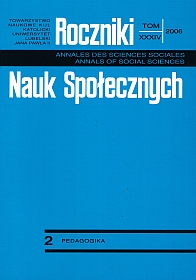Zaburzenia płynności mowy i kierunki terapii logopedycznej
Abstrakt
Research on disturbances in speech fluency and effect of these disturbances on inter-human communication make it possible to get a more complete knowledge about the mechanisms of speech. Results of this kind of investigations have also a practical function, as they allow defining the principles of prophylaxis and therapy in people who have trouble with speaking.
It should be noted that fluency of speech is expressed in the skill of connecting particular elements of an utterance, in a proper use of pauses, adequate rhythm and pace of speaking. Efficiency in connecting particular elements of an utterance comprises segmental and supra-segmental organization of the phonic sequence containing four levels. On the articulatory-phonetic level disturbances of fluency of speech are manifested in prolongation, omitting and repeating sounds and syllables. In this situation the speech therapist makes the decision concerning the kind of proceedings. Logotherapy, psychotherapy of pharmacological treatment are the most frequent methods. Logopedic proceedings aim at determining the proper pace of speaking, removing the difficulties in reading, developing musical capabilities, enriching the active vocabulary or broadening the concentration of attention. Therapy in people who stutter may be conducted by using various ways of teaching fluent speech. Relaxation is significant in therapy. When a stuttering person is relaxed the gravity of his disturbance decreases.
There are many programs, methods and techniques of therapy in stuttering persons. However, the decision about starting a proper action should be made after a thorough diagnosis. Then proper steps in therapy may be taken.
Bibliografia
Bloodstein O. (1981). A Handbook on Stuttering. Chicago: National Easter Seal Society for Crippled Children and Adults.
Brandford D. (1970). Cluttering. Folia Phoniatrica 1970, No 4-5.
Byrne R. (1989). Pomówmy o zacinaniu. Warszawa: PZWL.
Dalton P., Hardcastle W. J. (1977). Disorders of Fluency and their Effects on Communication. London: Edward Arnold (Publishers) Ltd.
Engiel Z. (1976). Próba opracowania systemu ćwiczeń logopedycznych w rehabilitacji jąkania. Cz. I. Zagadnienia Wychowawcze a Zdrowie Psychiczne, 6.
Engiel Z. (1977). Próba opracowania systemu ćwiczeń logopedycznych w rehabilitacji jąkania. Cz. II. Zagadnienia Wychowawcze a Zdrowie Psychiczne,3.
Essen O. von (1967). Fonetyka ogólna i stosowana. Warszawa: PWN.
Gałkowski T., Jastrzębowska G. (1999). Logopedia. Opole: Wydawnictwo Uniwersytetu Opolskiego.
Guitar B., Peters J. T. (1985). Stuttering: An Integratin of Contemporary Therapies. Published by Speech Foundation of America, No 16.
Grabias S. (1994). Język w zachowaniach społecznych. Lublin: Wydawnictwo UMCS.
Johnson W. (1959). The Onset of Stuttering. Minneapolis: University of Minnesota Press.
Koneczna H. (1965). Charakterystyka fonetyczna języka polskiego na tle innych języków słowiańskich, Warszawa.
Kostecka W. (1999). Pomoc logopedyczna dziecku jąkającemu się. Logopedia 26, 66-85.
Kostecka W. (2000). Dziecko i jąkanie. Poradnik dla rodziców, nauczycieli i logopedów. Lublin: Wyd. PTL.
Kostecka W. (2000). Model „góry lodowej” w opisie objawów jąkania u młodzieży i osób dorosłych. Biuletyn Logopedyczny 3, 45-47.
Kostecka W. (2001). Ramowy program diagnozy i terapii wczesnej niepłynności. Biuletyn Logopedyczny 2 (5), 37-40.
Kostecka W. (2004). Zintegrowany program terapii osób jąkających się. Lublin: AWH Antoni Dudek.
Łuria A. R. (1976). Podstawy neuropsychologii. Tłum. D. Kądzielawa. Warszawa: PZWL.
Richter E. (1967). Fizjopatologiczne podłoże jąkania. Logopedia 6.
Sheehan J. G. (1970). Stuttering: Research Therapy. New York: Harper Row.
Starkweather C. W., Gottwald S. R. (1990). The Demands & Capacities Model II: Chimical Applications. Journal of Fluency Disorders 15.
Styczek I. (1979). Logopedia. Warszawa: PWN.
Tarkowski Z., Smul M. (1988). Giełkot. Warszawa: Wyd. ZSL.
Tarkowski Z. (1999). Jąkanie. Warszawa: Wydawnictwo Naukowe PWN.
VanRiper Ch. (1963). Speech Correction: Principles and Methods 4th edn. New Jersey: Prentice-Hall, Englewood Cliffs.
VanRiper Ch. (1973). The Treatment Of Stuttering. New Jersey: Prentice-Hall Englewood Cliffs.
VanRiper Ch. (1982). The Nature of Stuttering. New Jersey: Prentice-Hall Englewood Cliffs.
Walsh K. (1998). Neuropsychologia kliniczna, Warszawa: Wydawnictwo Naukowe PWN.
Weiss D. A. (1964). Cluttering. Prentice-Hall Foundation of Speech Pathology Series.
Wierzchowska B. (1971). Wymowa polska. Warszawa: PZWS.
Woźniak T. (1994). Pojęcie jąkania a metodyka postępowania logopedycznego, w: Opuscula Logopaedica, Lublin: Wyd. UMCS, 313-319.
Copyright (c) 2006 Roczniki Nauk Społecznych

Utwór dostępny jest na licencji Creative Commons Uznanie autorstwa – Użycie niekomercyjne – Bez utworów zależnych 4.0 Międzynarodowe.


